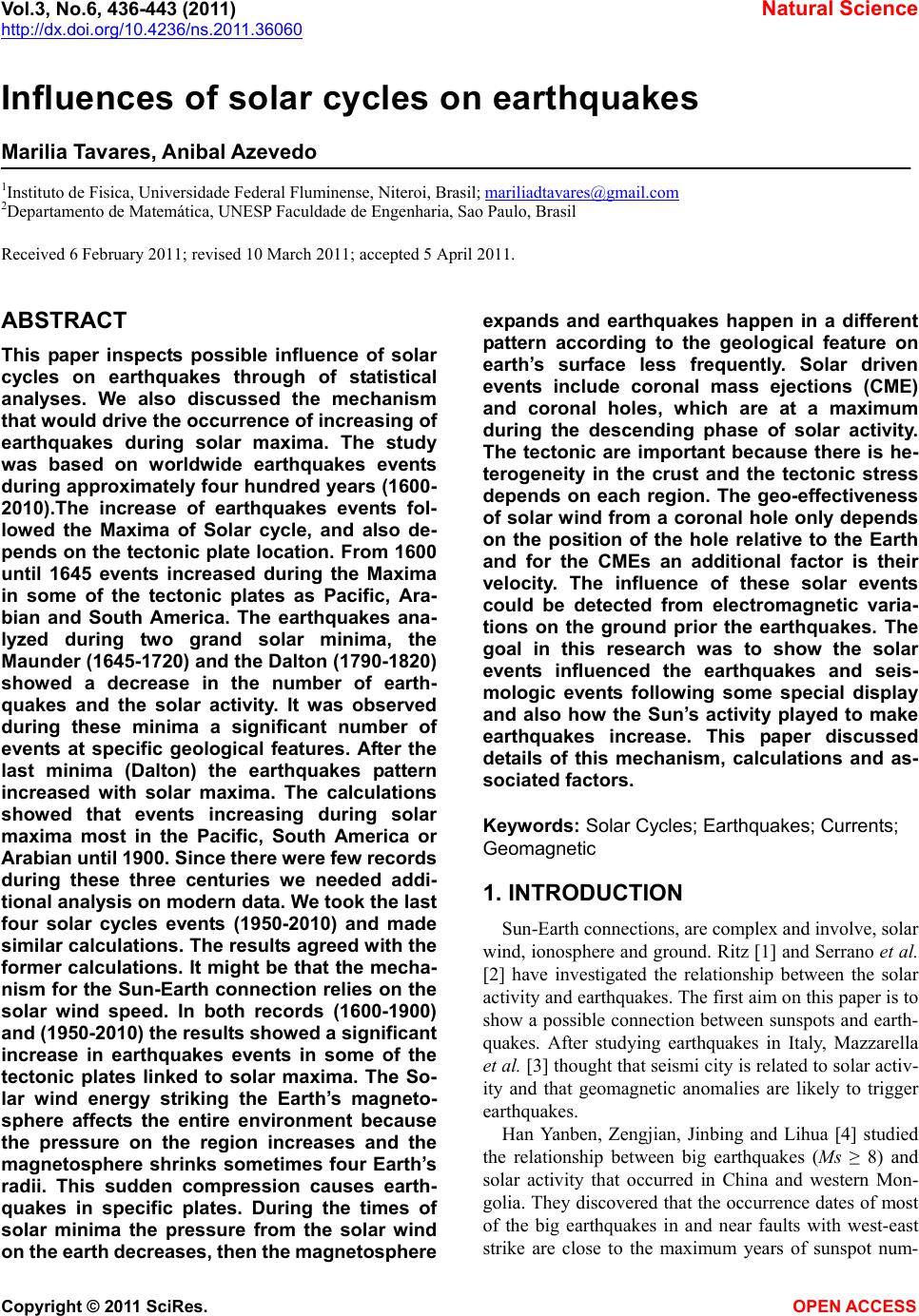 Vol.3, No.6, 436-443 (2011) Natural Science http://dx.doi.org/10.4236/ns.2011.36060 Copyright © 2011 SciRes. OPEN ACCESS Influences of solar cycles on earthquakes Marilia Tavares, Anibal Azevedo 1Instituto de Fisica, Universidade Federal Fluminense, Niteroi, Brasil; mariliadtavares@gmail.com 2Departamento de Matemática, UNESP Faculdade de Engenharia, Sao Paulo, Brasil Received 6 February 2011; revised 10 March 2011; accepted 5 April 2011. ABSTRACT This paper inspects possible influence of solar cycles on earthquakes through of statistical analyses. We also discussed the mechanism that would drive the occurrence of increasing of earthquakes during solar maxima. The study was based on worldwide earthquakes events during approximately four hundred years (1600- 2010).The increase of earthquakes events fol- lowed the Maxima of Solar cycle, and also de- pends on the tectonic plate location. From 1600 until 1645 events increased during the Maxima in some of the tectonic plates as Pacific, Ara- bian and South America. The earthquakes ana- lyzed during two grand solar minima, the Maunder (1645-1720) and the Dalton (1790-1820) showed a decrease in the number of earth- quakes and the solar activity. It was observed during these minima a significant number of events at specific geological features. After the last minima (Dalton) the earthquakes pattern increased with solar maxima. The calculations showed that events increasing during solar maxima most in the Pacific, South America or Arabian until 1900. Since there were few records during these three centuries we needed addi- tional analysis on modern data. We took the last four solar cycles events (1950-2010) and made similar calculations. The results agreed with the former calculations. It might be that the mecha- nism for the Sun-Earth connection relies on the solar wind speed. In both records (1600-1900) and (1950-2010) the results showed a significant increase in earthquakes events in some of the tectonic plates linked to solar maxima. The So- lar wind energy striking the Earth’s magneto- sphere affects the entire environment because the pressure on the region increases and the magnetosphere shrinks sometimes four Earth’s radii. This sudden compression causes earth- quakes in specific plates. During the times of solar minima the pressure from the solar wind on the earth decreases, then the magnetosphere expands and earthquakes happen in a different pattern according to the geological feature on earth’s surface less frequently. Solar driven events include coronal mass ejections (CME) and coronal holes, which are at a maximum during the descending phase of solar activity. The tectonic are important because there is he- terogeneity in the crust and the tectonic stress depends on each region. The geo-effectiveness of solar wind from a coronal hole only depends on the position of the hole relative to the Earth and for the CMEs an additional factor is their velocity. The influence of these solar events could be detected from electromagnetic varia- tions on the ground prior the earthquakes. The goal in this research was to show the solar events influenced the earthquakes and seis- mologic events following some special display and also how the Sun’s activity played to make earthquakes increase. This paper discussed details of this mechanism, calculations and as- sociated factors. Keywords: Solar Cycles; Earthquakes; Currents; Geomagnetic 1. INTRODUCTION Sun-Earth connections, are complex and involve, solar wind, ionosphere and ground. Ritz [1] and Serrano et al. [2] have investigated the relationship between the solar activity and earthquakes. The first aim on this paper is to show a possible connection between sunspots and earth- quakes. After studying earthquakes in Italy, Mazzarella et al. [3] thought that seismi city is related to solar activ- ity and that geomagnetic anomalies are likely to trigger earthquakes. Han Yanben, Zengjian, Jinbing and Lihua [4] studied the relationship between big earthquakes (Ms ≥ 8) and solar activity that occurred in China and western Mon- golia. They discovered that the occurrence dates of most of the big earthquakes in and near faults with west-east strike are close to the maximum years of sunspot num- 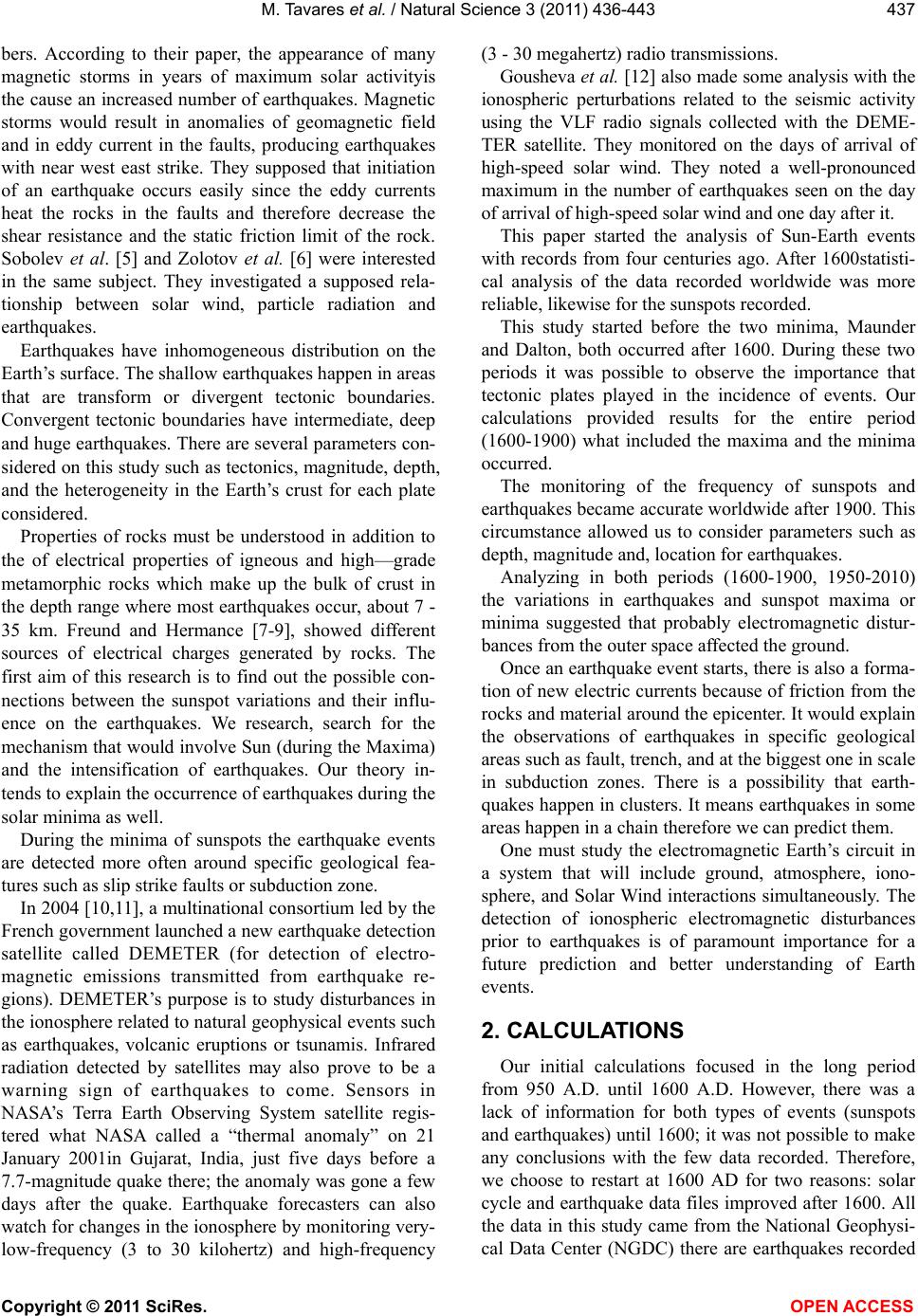 M. Tavares et al. / Natural Science 3 (2011) 436-443 Copyright © 2011 SciRes. OPEN ACCESS 437 bers. According to their paper, the appearance of many magnetic storms in years of maximum solar activityis the cause an increased number of earthquakes. Magnetic storms would result in anomalies of geomagnetic field and in eddy current in the faults, producing earthquakes with near west east strike. They supposed that initiation of an earthquake occurs easily since the eddy currents heat the rocks in the faults and therefore decrease the shear resistance and the static friction limit of the rock. Sobolev et al. [5] and Zolotov et al. [6] were interested in the same subject. They investigated a supposed rela- tionship between solar wind, particle radiation and earthquakes. Earthquakes have inhomogeneous distribution on the Earth’s surface. The shallow earthquakes happen in areas that are transform or divergent tectonic boundaries. Convergent tectonic boundaries have intermediate, deep and huge earthquakes. There are several parameters con- sidered on this study such as tectonics, magnitude, depth, and the heterogeneity in the Earth’s crust for each plate considered. Properties of rocks must be understood in addition to the of electrical properties of igneous and high—grade metamorphic rocks which make up the bulk of crust in the depth range where most earthquakes occur, about 7 - 35 km. Freund and Hermance [7-9], showed different sources of electrical charges generated by rocks. The first aim of this research is to find out the possible con- nections between the sunspot variations and their influ- ence on the earthquakes. We research, search for the mechanism that would involve Sun (during the Maxima) and the intensification of earthquakes. Our theory in- tends to explain the occurrence of earthquakes during the solar minima as well. During the minima of sunspots the earthquake events are detected more often around specific geological fea- tures such as slip strike faults or subduction zone. In 2004 [10,11], a multinational consortium led by the French government launched a new earthquake detection satellite called DEMETER (for detection of electro- magnetic emissions transmitted from earthquake re- gions). DEMETER’s purpose is to study disturbances in the ionosphere related to natural geophysical events such as earthquakes, volcanic eruptions or tsunamis. Infrared radiation detected by satellites may also prove to be a warning sign of earthquakes to come. Sensors in NASA’s Terra Earth Observing System satellite regis- tered what NASA called a “thermal anomaly” on 21 January 2001in Gujarat, India, just five days before a 7.7-magnitude quake there; the anomaly was gone a few days after the quake. Earthquake forecasters can also watch for changes in the ionosphere by monitoring very- low-frequency (3 to 30 kilohertz) and high-frequency (3 - 30 megahertz) radio transmissions. Gousheva et al. [12] also made some analysis with the ionospheric perturbations related to the seismic activity using the VLF radio signals collected with the DEME- TER satellite. They monitored on the days of arrival of high-speed solar wind. They noted a well-pronounced maximum in the number of earthquakes seen on the day of arrival of high-speed solar wind and one day after it. This paper started the analysis of Sun-Earth events with records from four centuries ago. After 1600statisti- cal analysis of the data recorded worldwide was more reliable, likewise for the sunspots recorded. This study started before the two minima, Maunder and Dalton, both occurred after 1600. During these two periods it was possible to observe the importance that tectonic plates played in the incidence of events. Our calculations provided results for the entire period (1600-1900) what included the maxima and the minima occurred. The monitoring of the frequency of sunspots and earthquakes became accurate worldwide after 1900. This circumstance allowed us to consider parameters such as depth, magnitude and, location for earthquakes. Analyzing in both periods (1600-1900, 1950-2010) the variations in earthquakes and sunspot maxima or minima suggested that probably electromagnetic distur- bances from the outer space affected the ground. Once an earthquake event starts, there is also a forma- tion of new electric currents because of friction from the rocks and material around the epicenter. It would explain the observations of earthquakes in specific geological areas such as fault, trench, and at the biggest one in scale in subduction zones. There is a possibility that earth- quakes happen in clusters. It means earthquakes in some areas happen in a chain therefore we can predict them. One must study the electromagnetic Earth’s circuit in a system that will include ground, atmosphere, iono- sphere, and Solar Wind interactions simultaneously. The detection of ionospheric electromagnetic disturbances prior to earthquakes is of paramount importance for a future prediction and better understanding of Earth events. 2. CALCULATIONS Our initial calculations focused in the long period from 950 A.D. until 1600 A.D. However, there was a lack of information for both types of events (sunspots and earthquakes) until 1600; it was not possible to make any conclusions with the few data recorded. Therefore, we choose to restart at 1600 AD for two reasons: solar cycle and earthquake data files improved after 1600. All the data in this study came from the National Geophysi- cal Data Center (NGDC) there are earthquakes recorded 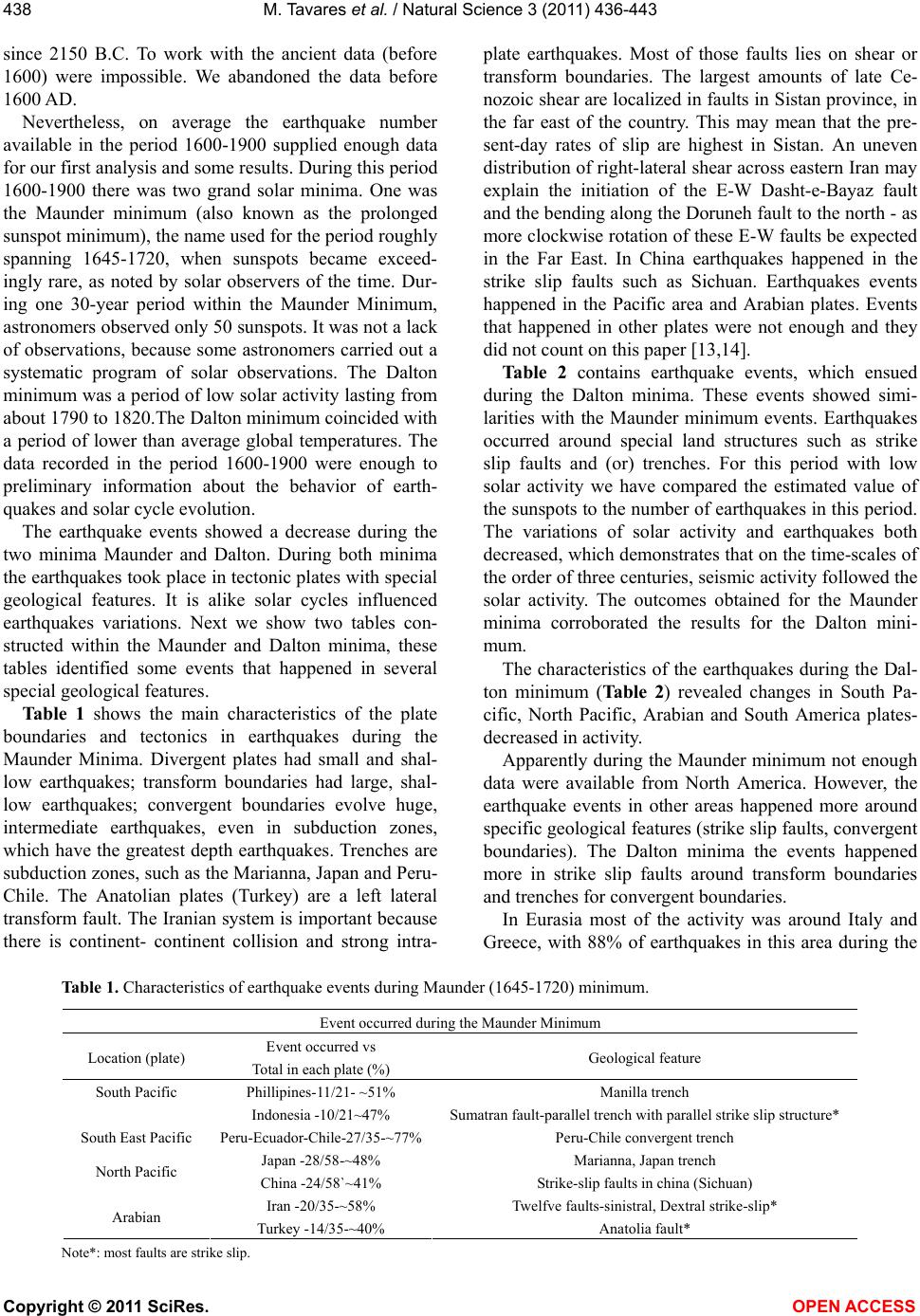 M. Tavares et al. / Natural Science 3 (2011) 436-443 Copyright © 2011 SciRes. OPEN ACCESS 438 since 2150 B.C. To work with the ancient data (before 1600) were impossible. We abandoned the data before 1600 AD. Nevertheless, on average the earthquake number available in the period 1600-1900 supplied enough data for our first analysis and some results. During this period 1600-1900 there was two grand solar minima. One was the Maunder minimum (also known as the prolonged sunspot minimum), the name used for the period roughly spanning 1645-1720, when sunspots became exceed- ingly rare, as noted by solar observers of the time. Dur- ing one 30-year period within the Maunder Minimum, astronomers observed only 50 sunspots. It was not a lack of observations, because some astronomers carried out a systematic program of solar observations. The Dalton minimum was a period of low solar activity lasting from about 1790 to 1820.The Dalton minimum coincided with a period of lower than average global temperatures. The data recorded in the period 1600-1900 were enough to preliminary information about the behavior of earth- quakes and solar cycle evolution. The earthquake events showed a decrease during the two minima Maunder and Dalton. During both minima the earthquakes took place in tectonic plates with special geological features. It is alike solar cycles influenced earthquakes variations. Next we show two tables con- structed within the Maunder and Dalton minima, these tables identified some events that happened in several special geological features. Table 1 shows the main characteristics of the plate boundaries and tectonics in earthquakes during the Maunder Minima. Divergent plates had small and shal- low earthquakes; transform boundaries had large, shal- low earthquakes; convergent boundaries evolve huge, intermediate earthquakes, even in subduction zones, which have the greatest depth earthquakes. Trenches are subduction zones, such as the Marianna, Japan and Peru- Chile. The Anatolian plates (Turkey) are a left lateral transform fault. The Iranian system is important because there is continent- continent collision and strong intra- plate earthquakes. Most of those faults lies on shear or transform boundaries. The largest amounts of late Ce- nozoic shear are localized in faults in Sistan province, in the far east of the country. This may mean that the pre- sent-day rates of slip are highest in Sistan. An uneven distribution of right-lateral shear across eastern Iran may explain the initiation of the E-W Dasht-e-Bayaz fault and the bending along the Doruneh fault to the north - as more clockwise rotation of these E-W faults be expected in the Far East. In China earthquakes happened in the strike slip faults such as Sichuan. Earthquakes events happened in the Pacific area and Arabian plates. Events that happened in other plates were not enough and they did not count on this paper [13,14]. Table 2 contains earthquake events, which ensued during the Dalton minima. These events showed simi- larities with the Maunder minimum events. Earthquakes occurred around special land structures such as strike slip faults and (or) trenches. For this period with low solar activity we have compared the estimated value of the sunspots to the number of earthquakes in this period. The variations of solar activity and earthquakes both decreased, which demonstrates that on the time-scales of the order of three centuries, seismic activity followed the solar activity. The outcomes obtained for the Maunder minima corroborated the results for the Dalton mini- mum. The characteristics of the earthquakes during the Dal- ton minimum (Table 2) revealed changes in South Pa- cific, North Pacific, Arabian and South America plates- decreased in activity. Apparently during the Maunder minimum not enough data were available from North America. However, the earthquake events in other areas happened more around specific geological features (strike slip faults, convergent boundaries). The Dalton minima the events happened more in strike slip faults around transform boundaries and trenches for convergent boundaries. In Eurasia most of the activity was around Italy and Greece, with 88% of earthquakes in this area during the Table 1. Characteristics of earthquake events during Maunder (1645-1720) minimum. Event occurred during the Maunder Minimum Location (plate) Event occurred vs Total in each plate (%) Geological feature South Pacific Phillipines-11/21- ~51% Manilla trench Indonesia -10/21~47% Sumatran fault-parallel trench with parallel strike slip structure* South East Pacific Peru-Ecuador-Chile-27/35-~77%Peru-Chile convergent trench Japan -28/58-~48% Marianna, Japan trench North Pacific China -24/58`~41% Strike-slip faults in china (Sichuan) Iran -20/35-~58% Twelfve faults-sinistral, Dextral strike-slip* Arabian Turkey -14/35-~40% Anatolia fault* Note*: most faults are strike slip. 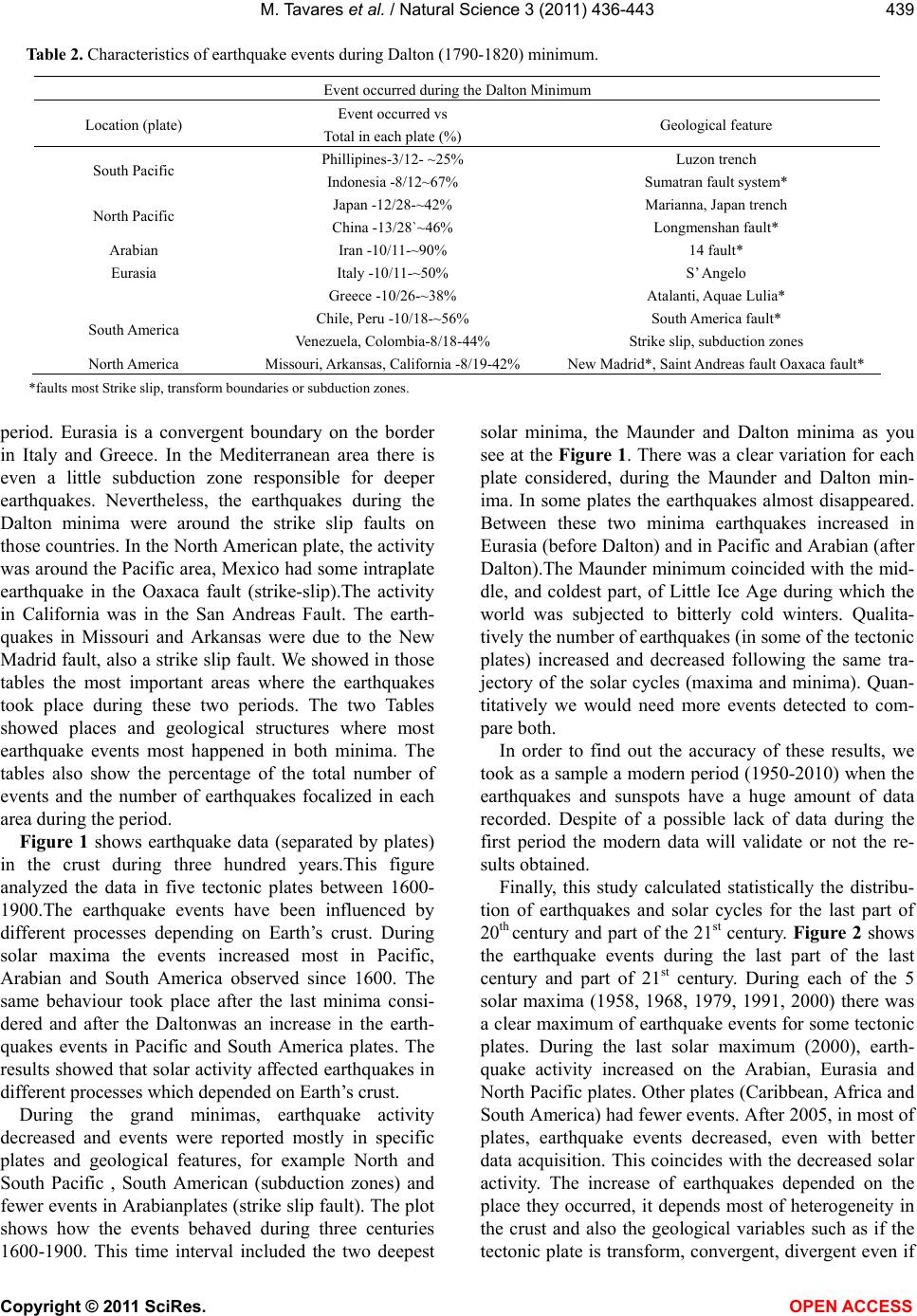 M. Tavares et al. / Natural Science 3 (2011) 436-443 Copyright © 2011 SciRes. OPEN ACCESS 439 Table 2. Characteristics of earthquake events during Dalton (1790-1820) minimum. Event occurred during the Dalton Minimum Location (plate) Event occurred vs Total in each plate (%) Geological feature Phillipines-3/12- ~25% Luzon trench South Pacific Indonesia -8/12~67% Sumatran fault system* Japan -12/28-~42% Marianna, Japan trench North Pacific China -13/28`~46% Longmenshan fault* Arabian Iran -10/11-~90% 14 fault* Eurasia Italy -10/11-~50% S’ Angelo Greece -10/26-~38% Atalanti, Aquae Lulia* Chile, Peru -10/18-~56% South America fault* South America Venezuela, Colombia-8/18-44% Strike slip, subduction zones North America Missouri, Arkansas, California -8/19-42% New Madrid*, Saint Andreas fault Oaxaca fault* *faults most Strike slip, transform boundaries or subduction zones. period. Eurasia is a convergent boundary on the border in Italy and Greece. In the Mediterranean area there is even a little subduction zone responsible for deeper earthquakes. Nevertheless, the earthquakes during the Dalton minima were around the strike slip faults on those countries. In the North American plate, the activity was around the Pacific area, Mexico had some intraplate earthquake in the Oaxaca fault (strike-slip).The activity in California was in the San Andreas Fault. The earth- quakes in Missouri and Arkansas were due to the New Madrid fault, also a strike slip fault. We showed in those tables the most important areas where the earthquakes took place during these two periods. The two Tables showed places and geological structures where most earthquake events most happened in both minima. The tables also show the percentage of the total number of events and the number of earthquakes focalized in each area during the period. Figure 1 shows earthquake data (separated by plates) in the crust during three hundred years.This figure analyzed the data in five tectonic plates between 1600- 1900.The earthquake events have been influenced by different processes depending on Earth’s crust. During solar maxima the events increased most in Pacific, Arabian and South America observed since 1600. The same behaviour took place after the last minima consi- dered and after the Daltonwas an increase in the earth- quakes events in Pacific and South America plates. The results showed that solar activity affected earthquakes in different processes which depended on Earth’s crust. During the grand minimas, earthquake activity decreased and events were reported mostly in specific plates and geological features, for example North and South Pacific , South American (subduction zones) and fewer events in Arabianplates (strike slip fault). The plot shows how the events behaved during three centuries 1600-1900. This time interval included the two deepest solar minima, the Maunder and Dalton minima as you see at the Figure 1. There was a clear variation for each plate considered, during the Maunder and Dalton min- ima. In some plates the earthquakes almost disappeared. Between these two minima earthquakes increased in Eurasia (before Dalton) and in Pacific and Arabian (after Dalton).The Maunder minimum coincided with the mid- dle, and coldest part, of Little Ice Age during which the world was subjected to bitterly cold winters. Qualita- tively the number of earthquakes (in some of the tectonic plates) increased and decreased following the same tra- jectory of the solar cycles (maxima and minima). Quan- titatively we would need more events detected to com- pare both. In order to find out the accuracy of these results, we took as a sample a modern period (1950-2010) when the earthquakes and sunspots have a huge amount of data recorded. Despite of a possible lack of data during the first period the modern data will validate or not the re- sults obtained. Finally, this study calculated statistically the distribu- tion of earthquakes and solar cycles for the last part of 20th century and part of the 21st century. Figure 2 shows the earthquake events during the last part of the last century and part of 21st century. During each of the 5 solar maxima (1958, 1968, 1979, 1991, 2000) there was a clear maximum of earthquake events for some tectonic plates. During the last solar maximum (2000), earth- quake activity increased on the Arabian, Eurasia and North Pacific plates. Other plates (Caribbean, Africa and South America) had fewer events. After 2005, in most of plates, earthquake events decreased, even with better data acquisition. This coincides with the decreased solar activity. The increase of earthquakes depended on the place they occurred, it depends most of heterogeneity in the crust and also the geological variables such as if the tectonic plate is transform, convergent, divergent even if 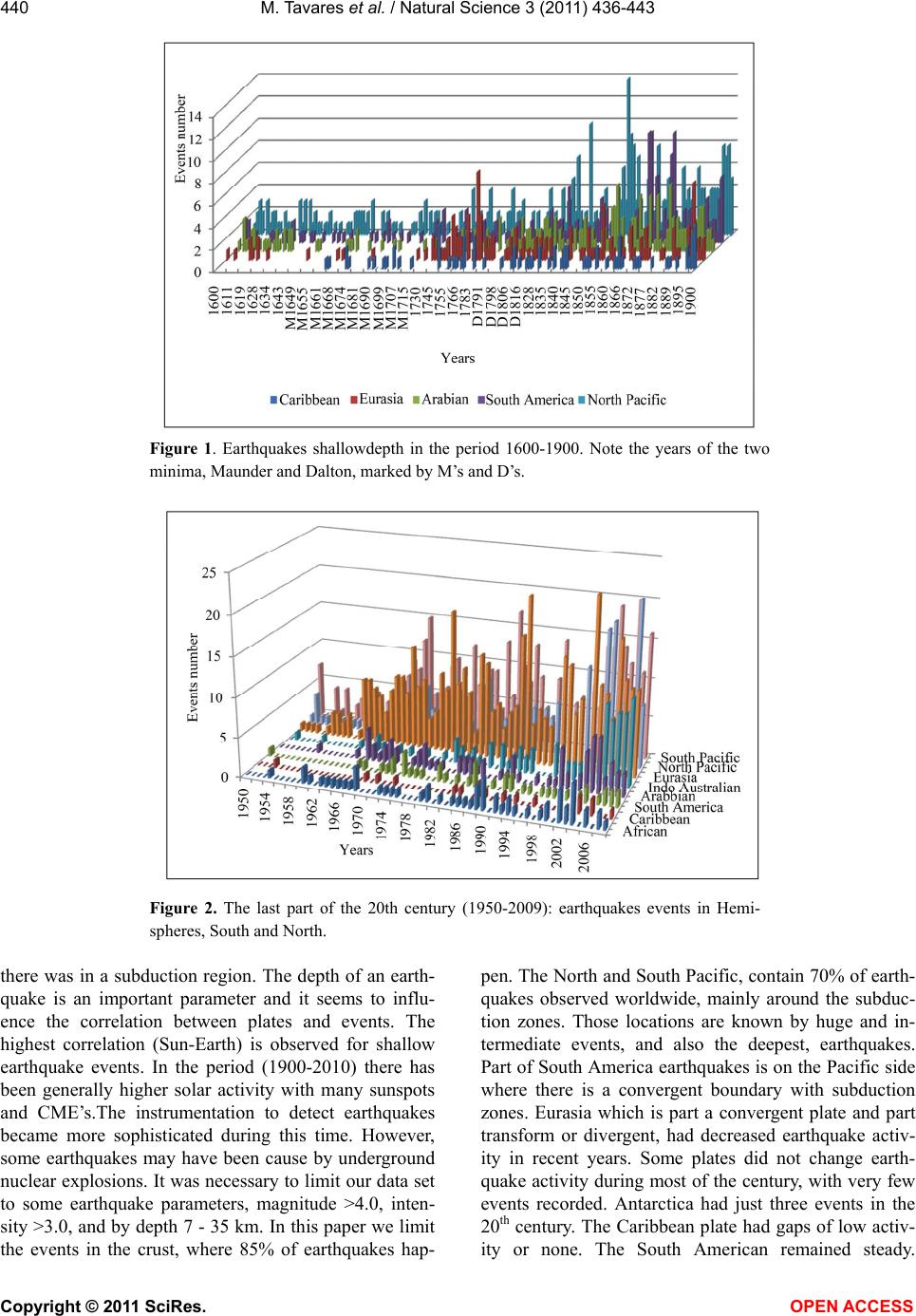 M. Tavares et al. / Natural Science 3 (2011) 436-443 Copyright © 2011 SciRes. OPEN ACCESS 440 Figure 1. Earthquakes shallowdepth in the period 1600-1900. Note the years of the two minima, Maunder and Dalton, marked by M’s and D’s. Figure 2. The last part of the 20th century (1950-2009): earthquakes events in Hemi- spheres, South and North. there was in a subduction region. The depth of an earth- quake is an important parameter and it seems to influ- ence the correlation between plates and events. The highest correlation (Sun-Earth) is observed for shallow earthquake events. In the period (1900-2010) there has been generally higher solar activity with many sunspots and CME’s.The instrumentation to detect earthquakes became more sophisticated during this time. However, some earthquakes may have been cause by underground nuclear explosions. It was necessary to limit our data set to some earthquake parameters, magnitude >4.0, inten- sity >3.0, and by depth 7 - 35 km. In this paper we limit the events in the crust, where 85% of earthquakes hap- pen. The North and South Pacific, contain 70% of earth- quakes observed worldwide, mainly around the subduc- tion zones. Those locations are known by huge and in- termediate events, and also the deepest, earthquakes. Part of South America earthquakes is on the Pacific side where there is a convergent boundary with subduction zones. Eurasia which is part a convergent plate and part transform or divergent, had decreased earthquake activ- ity in recent years. Some plates did not change earth- quake activity during most of the century, with very few events recorded. Antarctica had just three events in the 20th century. The Caribbean plate had gaps of low activ- ity or none. The South American remained steady.  M. Tavares et al. / Natural Science 3 (2011) 436-443 Copyright © 2011 SciRes. OPEN ACCESS 441 Comparing the events by Hemisphere, Southern is less activity during the solar maxima than the Northern. An anomaly behavior was the activity in Indo-Australian plates where the number of earthquakes is growing even after the last solar maxima observed. After 2005 most plates analyzed even showed a decrease in the earth- quake events. This paper uses data from only eight of the plates since the other four plates have not had events recorded continuously or even frequently. Figure 3 shows the trend-line for earthquake events during the last 60 years. The activity increased in the period of sunspot maxima. It is calculated that a regres- sion that would show a relationship among tectonic plates. Probably some plates have an interconnection with one another concerning earthquakes. They are North Pacific depth 10 - 20 km, 20 - 30 km, Indo Aus- tralian 10 - 20 km, Arabian 0 - 10km, Eurasia 10 - 20 km. If plates appear to have correlated earthquake events, then an earthquake in one of them induces one in another. The trend line concerns the North Pacific plate and its relationship with other plates. If an event happens in the North Pacific plates the possibility is 31% there will be a next event in other plates. The connections among events are very complicated to analyze; some event may possibly attached to another one without sun correlation. If one event happens in on plate it correlates other event in the nearby plate. This point will be clear up with mathematical models that give us the probability that one event happen in one or another plate. It is also possible that some Sun storm events disturb the ground and ignites a first earthquake followed by a cluster. At this point more studies are necessary since the seismological community attention focused on me- chanical processes as rocks deform as a macroscopic body, on when and where micro cracks appear, what role the water plays and intergranular water films when and how seismic slip may occur. Seismologists need new tools that can provide information before the rocks reach the critical point of rupture. It is necessary to study pre- earthquake events and seismological electromagnetic waves before and after an earthquake. 3. RESULTS We found that during solar minima earthquakes oc- curred mostly along the strike slip faults that had had a long rest, such as the New Madrid (1811-1812), Loma Prieta (1989), Haiti (2010), [15,16]. Some major earth- quakes happened during solar minima such as observed by Akhoondzadeh et al. [17]. Besides the seismological characteristics (they occurred in subduction zones or strike slip faults), it looked connected with the variations in the speed of solar wind. Let make a briefly analysis in the New Madrid earthquakes. It happened 1811-1812 in a chain of earthquakes. It happened in a minimum be- tween the Cycle 5 and Cycle 6 those had a very few number of sunspots during the maxima. They were the two lowest maxima since 1700. We supposed that Solar wind pressure has been feeble during this time and the Earth surface released energy in places where the tec- tonic was compatible with the observations during other minima. Finally, for the last half past of the 20th century (1960- Figure 3. Earthquake events vs.yearscorrelation and regression line. 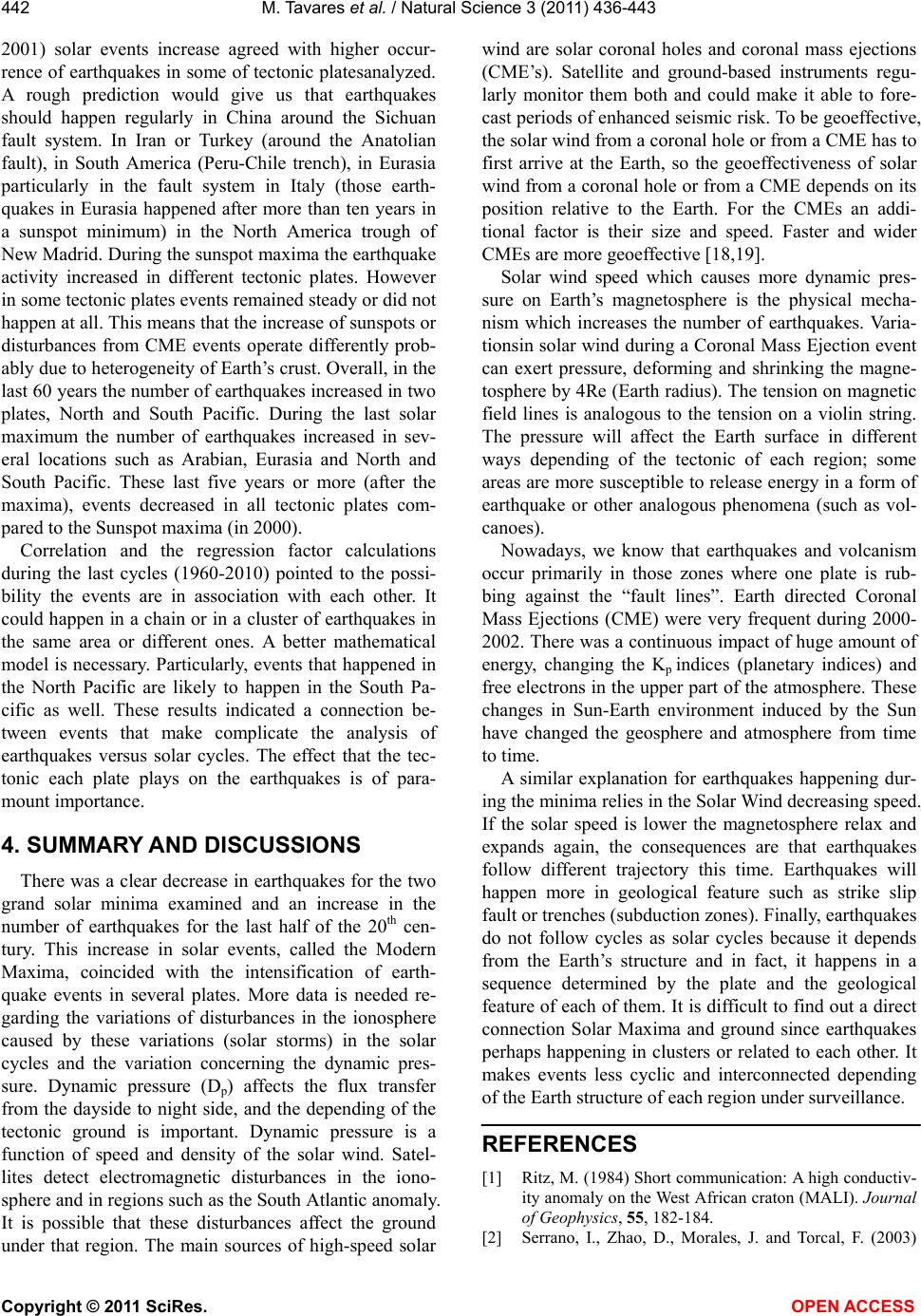 M. Tavares et al. / Natural Science 3 (2011) 436-443 Copyright © 2011 SciRes. OPEN ACCESS 442 2001) solar events increase agreed with higher occur- rence of earthquakes in some of tectonic platesanalyzed. A rough prediction would give us that earthquakes should happen regularly in China around the Sichuan fault system. In Iran or Turkey (around the Anatolian fault), in South America (Peru-Chile trench), in Eurasia particularly in the fault system in Italy (those earth- quakes in Eurasia happened after more than ten years in a sunspot minimum) in the North America trough of New Madrid. During the sunspot maxima the earthquake activity increased in different tectonic plates. However in some tectonic plates events remained steady or did not happen at all. This means that the increase of sunspots or disturbances from CME events operate differently prob- ably due to heterogeneity of Earth’s crust. Overall, in the last 60 years the number of earthquakes increased in two plates, North and South Pacific. During the last solar maximum the number of earthquakes increased in sev- eral locations such as Arabian, Eurasia and North and South Pacific. These last five years or more (after the maxima), events decreased in all tectonic plates com- pared to the Sunspot maxima (in 2000). Correlation and the regression factor calculations during the last cycles (1960-2010) pointed to the possi- bility the events are in association with each other. It could happen in a chain or in a cluster of earthquakes in the same area or different ones. A better mathematical model is necessary. Particularly, events that happened in the North Pacific are likely to happen in the South Pa- cific as well. These results indicated a connection be- tween events that make complicate the analysis of earthquakes versus solar cycles. The effect that the tec- tonic each plate plays on the earthquakes is of para- mount importance. 4. SUMMARY AND DISCUSSIONS There was a clear decrease in earthquakes for the two grand solar minima examined and an increase in the number of earthquakes for the last half of the 20th cen- tury. This increase in solar events, called the Modern Maxima, coincided with the intensification of earth- quake events in several plates. More data is needed re- garding the variations of disturbances in the ionosphere caused by these variations (solar storms) in the solar cycles and the variation concerning the dynamic pres- sure. Dynamic pressure (Dp) affects the flux transfer from the dayside to night side, and the depending of the tectonic ground is important. Dynamic pressure is a function of speed and density of the solar wind. Satel- lites detect electromagnetic disturbances in the iono- sphere and in regions such as the South Atlantic anomaly. It is possible that these disturbances affect the ground under that region. The main sources of high-speed solar wind are solar coronal holes and coronal mass ejections (CME’s). Satellite and ground-based instruments regu- larly monitor them both and could make it able to fore- cast periods of enhanced seismic risk. To be geoeffective, the solar wind from a coronal hole or from a CME has to first arrive at the Earth, so the geoeffectiveness of solar wind from a coronal hole or from a CME depends on its position relative to the Earth. For the CMEs an addi- tional factor is their size and speed. Faster and wider CMEs are more geoeffective [18,19]. Solar wind speed which causes more dynamic pres- sure on Earth’s magnetosphere is the physical mecha- nism which increases the number of earthquakes. Varia- tionsin solar wind during a Coronal Mass Ejection event can exert pressure, deforming and shrinking the magne- tosphere by 4Re (Earth radius). The tension on magnetic field lines is analogous to the tension on a violin string. The pressure will affect the Earth surface in different ways depending of the tectonic of each region; some areas are more susceptible to release energy in a form of earthquake or other analogous phenomena (such as vol- canoes). Nowadays, we know that earthquakes and volcanism occur primarily in those zones where one plate is rub- bing against the “fault lines”. Earth directed Coronal Mass Ejections (CME) were very frequent during 2000- 2002. There was a continuous impact of huge amount of energy, changing the Kp indices (planetary indices) and free electrons in the upper part of the atmosphere. These changes in Sun-Earth environment induced by the Sun have changed the geosphere and atmosphere from time to time. A similar explanation for earthquakes happening dur- ing the minima relies in the Solar Wind decreasing speed. If the solar speed is lower the magnetosphere relax and expands again, the consequences are that earthquakes follow different trajectory this time. Earthquakes will happen more in geological feature such as strike slip fault or trenches (subduction zones). Finally, earthquakes do not follow cycles as solar cycles because it depends from the Earth’s structure and in fact, it happens in a sequence determined by the plate and the geological feature of each of them. It is difficult to find out a direct connection Solar Maxima and ground since earthquakes perhaps happening in clusters or related to each other. It makes events less cyclic and interconnected depending of the Earth structure of each region under surveillance. REFERENCES [1] Ritz, M. (1984) Short communication: A high conductiv- ity anomaly on the West African craton (MALI). Journal of Geophysics, 55, 182-184. [2] Serrano, I., Zhao, D., Morales, J. and Torcal, F. (2003)  M. Tavares et al. / Natural Science 3 (2011) 436-443 Copyright © 2011 SciRes. OPEN ACCESS 443 Seismic tomography from local crustal earthquakes be- neath eastern Rif Mountains of Morocco, Tectonic Phys- ics, 367, 187-201. [3] Mazzarella, A. and Palumbo, A. (1988) Solar geomag- netic and seismic activity, NuovoCimento C, Serie, 1, 353-364. [4] Han, Y.B., Guo, Z.J., Wu, Jinbing and Ma, L.H. (2004) Possible triggering of solar activity to big earthquakes (Ms ≥ 8) in faults with near west-east strike in China. Science in China Series G Physics, Mechanics and As- tronomy, 47, 173-181. [5] Sobolev, G.A., Shestopalov, I.P. and Kharin, E.P. (1998) Geoeffective solar flashes and seismic activity of the Earth, FizikaZemli (in Russian), 7, 85-90. [6] Zolotov O.V., Namgaladze A.A., Zkharenkova, I.E, Sha- gimuratov, I.I. and Martynenko, O.V. (2010) Modeling of ionospheric earthquake precursors generated by various electric field sources. Natural Hazards Earth System Sciences, 10, 7-18. [7] Freund, F.T. (2007) Pre earthquake signals- Part I: De- viatoric stresses turn rocks into a source of electric cur- rents. Natural Hazards and Earth System Sciences, 7, 535-541. [8] Freund, F.T. (2007) Pre earthquake signals—Part II: Flow of battery currents in the crust. Natural Hazard Earth System Sciences, 7, 543-548. [9] Hermance, J.F. (1995) Electrical conductivity models of the crust and mantle—Global Earth Physics. A Handbook of Physical Constants, AGU Reference, Copyright 1995. [10] Biagi, P.F., Piccolo, R., Ermini, A., Martelluci S., Bel- lecci C., Hayakawa, M., Capozzi, V. and Kingsley, S.P. (2001) Possible earthquakes precursors revealed by LF radio signals. Natural Hazard and Earth System Sciences, 1, 99-104. [11] Inan, U.S., Piddyachiy, D., Peter, W.B., Sauvaud, J.A. and M-Demeter, P. (2007) Satellite observations of light- ning induced precipitation. Geophysical Research Letters, 34, L07013. [12] Gousheva, M.N., Georgiva, K.Y., Kirov, B.B. and Atanssov, D. (2003) On the relation between solar activ- ity and seismicity. Proceedings of International Confer- ence on Recent Advances in Space Technologies, 20-22 November 2003. [13] Qian, F. Y., Zhao, Y. L. and Lu, J. (1997) Georesistivity precursors to the Tangshan earthquake. Annals of Geo- physics, Annals of Geophysics, 40, 251-260. [14] Fukao, Y., Koyama, T., Obayashi, M. and Utada, H. (2004) Trans Pacific temperature field in the mantle tran- sition region from seismic and electromagnetic tomo- graphy. Earth and Planetary Science Letters, 217, 425-434. [15] Bleckia, J.C., Parroth, M. and Wronowskia, R. (2010) Plasma turbulence in the ionosphere prior to earthquakes some remarks on the Demeter registrations. Journal of Asian Earth Sciences, 41, 450-458. [16] Akhoondzadeh, M. et al. (2010) Electron and ion density variations before strong earthquakes. Natural Hazards Earth System Sciences, 10, 7-18. doi:10.5194/nhess-10-7-2010 [17] Mukherjee, S. (2008) Cosmic Influence on the Sun-Earth Environment, Sensors, 8, 7736-7752. [18] Namgaladze, A.A, Zolotov, O.V., Zakarenkhova, I.E., Shagimuratov, I.I. and Martynenko, O.V. (2009) Iono- spheric total electron content variations observed before earthquakes: Possible physical mechanism and modeling. Proceedings of MSTU, 12, 308-315. [19] Fraser-Smith, A.C., Bernardi, A., McGill, P.R, Ladd, M.E., Helliwell, R.A. and Villard, O.G. (1990) Low- Frequency magnetic field measurements near the epicen- ter of the Ms 7.1 LomaPrieta Earthquake. Geophysics Research Letters, 17, 1465-1468.
|